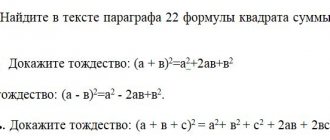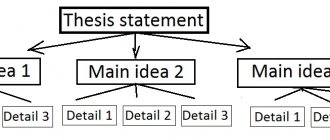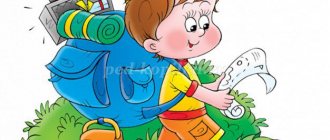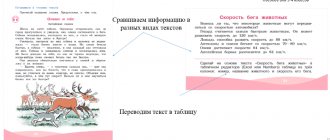The importance of innovative activity in a preschool institution
Innovation (eng. innovation) - innovation, innovation. The use of innovations in kindergarten involves the introduction into the educational process of updated, improved and unique ideas obtained through the creative efforts of the teacher. The goal of innovative activity in a preschool institution is to increase the efficiency of the learning process and obtain better results.
When carrying out innovative activities, the preschool teacher is given the following tasks:
- development of the individuality of pupils;
- developing children's initiative, independence, and ability for creative self-expression;
- increasing curiosity and interest in research activities;
- stimulation of various types of activity of pupils (play, cognitive, etc.);
- increasing the intellectual level of children;
- development of creativity and innovative thinking.
Those who do not use new means must expect new troubles.
Francis Bacon, English philosopher
An important difference between innovative activities and traditional ones is that the teacher plays the role not of a mentor, but of an accomplice in the process and adheres to the position “not next to, not above, but together.” Thus, the child feels more freedom, which encourages greater creative activity. And also, knowledge is not given to the student in a ready-made form, as before, but is obtained by the child himself in the course of his research activities.
Types of innovative pedagogical technologies in preschool educational institutions
Innovative pedagogical technologies include:
- health-saving;
- technologies of design and research activities;
- information and communication;
- lapbook technologies;
- person-oriented;
- gaming technologies;
- problem-based learning technologies, etc.
Project technologies
Project activities in kindergarten involve conducting joint group projects. In the process of their implementation, preschoolers actively develop cognitive and research abilities. This helps the development of an independent creative personality capable of solving complex problems. If in traditional educational activities the learning process involves providing students with ready-made information, then project activities allow children to come to the result themselves.
During the implementation of the project, children’s cognitive activity increases
The practice of modern work of a preschool institution identifies the following types of project activities:
- Research - children conduct experiments and then draw up the results, for example, in the form of a newspaper or drawing.
- Playful - involves taking on the role of a character in a story or fairy tale.
- Informational - children collect information on a certain topic, and then implement the work done in the form of drawings, exhibitions, collages, stories.
- Creative - usually does not have a clearly developed structure and involves the joint work of children and the teacher. The result can be exhibitions, albums, newspapers, etc.
For each preschool age, the project solves different problems depending on the children’s skills and interests. Social-family (“Family Tree”) and educational projects (“Animals and Birds,” “My Friends,” “Plants Around Us”) will be useful for preschoolers of any age.
Using a lapbook
A laptop, or interactive folder, is a homemade folding book that can contain all sorts of elements: pockets, doors, envelopes, etc. A laptop is the result of the joint activity of a teacher and children. It collects material on a specific topic. This method provides the child with the opportunity to familiarize himself with the visual material - he decides how to interact with the lapbook, folds and opens certain parts at will.
A laptop will help you consolidate the material you have covered, as well as periodically remind you of it in the future. This interactive folder is often used at the final stage of project activity. The laptop is well suited for use in groups of different ages. For example, information can be distributed in this way: for younger preschoolers, provide envelopes with pictures of animals inside, and leave for older children material where they need to apply reading, counting skills, etc.
Lapbook - an amazing book with tasks that preschoolers work with with enthusiasm
For older children, it is better to highlight specific topics. For example, highlight individual types of insects in one lapbook: for example, use information only about butterflies, highlight their species, or pay attention to beetles, etc.
Making a laptop
For the base of a lapbook, it is best to use A3 cardboard, but any other dense material will do. Nowadays you can find special cardboard base folders in stores. Then all that remains is to paste the base with the necessary details and paint it. If you use cardboard or a sheet of thick paper, then fold it in half, like a book, or into 3 parts so that it looks like a door. You can fold the base into an accordion shape. And then add any details you wish. These can be pockets with cards, small brochures, envelopes, etc. Each envelope or pocket is filled with thematic material: cards, drawings, riddles, etc.
You can fold a lapbook in any convenient way, it all depends on the imagination of the creator
Next, the base is filled together by children and teachers with the necessary materials. Let’s give an example of filling out a lapbook on the topic of the environmental project “Take care of nature”; it consists of 7 games and activities:
- Game "Who eats what?" is a rotating picture in which you need to match the animal with the type of food it eats.
You need to rotate the circle to match the food to a specific animal.
2. A book with finger games on the theme of nature. Finger games will help develop fine motor skills and relieve tension.
3. A bag of garbage. By assembling it, children learn to maintain order and develop fine motor skills.
By learning to put garbage in a toy bag, children will become more tidy at home.
- The game in an envelope “Whose House” consists of cards with animals and different types of dwellings. Children need to match them.
To complete the task, you need to match the animal and its place of residence
- 4 envelopes with different seasons. It is required to place the cards with the corresponding signs in the required envelope.
- 4 pictures of different birds, next to a square with Velcro, on which you need to stick a card with the type of food that each bird eats.
Every bird needs the right food
- Drawing of the game “Walk along the path and don’t touch the flowers.” Teaches you to be attentive.
When designing a lapbook, you can use pieces of colored paper, fabric and various decorative elements.
The finished lapbook can be used in classes, recalling and consolidating the material covered, and children can also look at it independently in their free time.
Cards for recording the results of experimental activities
Experimental activities are one of the favorite activities of preschoolers, because it is inherent in children by nature to conduct experiments and explore something new. The final stage of any work done is summing up and drawing conclusions. The verbal method is the usual method for this. Innovative is the use of so-called results cards, which have recently become increasingly popular. This is a graphical method. Information formatted this way is easier to remember.
Using pictures, the scheme of the experiment becomes clearer
Working with cards is based on previously obtained ideas and your own assumptions. Children conduct experiments based on information cards, and also mark all their observations there.
Development of an innovative project in kindergarten
Of course, innovative activity as a new type of work with children has its share of risks. But if you think through all the nuances when organizing upcoming activities, these risks will be minimized. The teacher should consider:
- choosing the direction of innovation work;
- development of a concept and program for innovation activities;
- creating conditions for the implementation of an innovative project;
- preparation and competent introduction of documentation on innovation activities.
Before introducing an innovative project into work with children, the teacher should carefully study all the nuances of the chosen topic
The task of an innovative teacher is to create motivation for the group to participate in joint activities, taking into account the individual characteristics of each student and his psychological readiness.
Structure of the innovation process:
- Analysis and collection of information.
- Selection and implementation of innovations.
- Generalization of experience and diagnostics of introduced information.
Innovation activity
Support and accompaniment of gifted children
Since 2004, in accordance with the Working Concept of Giftedness of the Ministry of Education and Science of Russia, the federal target program “Gifted Children”, work has been carried out in kindergarten to support and accompany gifted children through the use of elements of the OTSM-TRIZ technology (general theory of strong thinking; theory of solving inventive problems) .
For this purpose, a comprehensive and targeted work plan has been created, providing for scientific and methodological support of the process, the creation of creative groups of teachers, the preparation of teaching aids, games for the introduction of methods and technologies aimed at developing the intellectual and creative potential of children.
Since 2006, on the initiative of the scientific-practical one, created on the basis of the Academic Lyceum of Tomsk, within the framework of the “Gifted Child” program, teachers of our preschool educational institution have continued to work on the development of general childhood giftedness in preschool children in close cooperation with three kindergartens in the city of Tomsk. The leading form of interaction between gardens has become the annual Festival of Intellectual Kids.
The main goal of the festival: the development of the intellectual and creative potential of preschool children and the mechanisms of social partnership in the education system and the development of giftedness in preschool children. The subjects of FIMs are varied and are usually dedicated to a significant literary date or an important event in the life of the country. In this regard, competition tasks are being developed.
Since March 2011, MADOU No. 40 was assigned the status of a municipal innovation platform on the topic “Methodological constructor as a way to improve the professional competence of preschool educational institution teachers in the development of children's giftedness.”
Strategic goal:
- creating conditions in preschool educational institutions for achieving stable results in the development of children's giftedness.
Objective of the project:
- increasing the professional competence of preschool teachers on the development of children's giftedness;
- ensuring an individual educational trajectory for the development of children’s intellectual talent in various types of activities.
The project resulted in methodological developments:
- TRIZ lesson designer;
- Gifted Development Constructor;
- Intellectual game designer;
- Parent meeting designer.
These materials help teachers in planning and conducting educational activities with students and parents.
On June 14, 2013, the expert council of the Tomsk Department of Education awarded the kindergarten the status of an innovative platform on the topic “Creating conditions for the introduction of the new generation basic general education program “Success” into the practice of preschool educational institutions based on network interaction of preschool educational institutions.” Teachers from three preschool educational institutions No. 40 (II building), No. 62, No. 86 are taking part in the implementation of the innovative project.
Briefly about the project:
In connection with the introduction first of FGT to the structure of the main educational program of preschool education, and then of the Federal State Educational Standard for Preschool Education in preschool education, a change in approaches to the content of education occurred. The previous model of organizing the educational process did not meet the new requirements. I really wanted to take more into account the individual characteristics and interests of children and give them the right to choose. After analyzing various sample educational programs, we chose the “Success” program. The “Success” program was the first program created in accordance with the new requirements. The content of the program and new forms of joint activities between children and adults are relevant and timely. The basis for the implementation of the complex thematic principle of constructing the Program is the holiday calendar . Children love holidays very much. Preparing for and conducting them is a strong motivating factor for students. An important point for us was also that mastering the program is realized through the work of children in children's activity centers: they themselves choose the type of activity, the sequence of work, and like-minded people in creativity.
The idea of network interaction became the leading one in the implementation of the project.
Network interaction has recently become particularly relevant in many areas of our lives. Network interaction is actively used in economics, business, science, and culture. And the education system is a clear confirmation of this. Our modern life poses a lot of problems that are difficult to solve alone. A lonely traveler, not knowing the exact path, always ends up in a thicket. So, in order not to get caught in the thicket in the era of changes in the preschool education system, we decided to join forces and jointly look for ways to solve the problems. Thus began the implementation of an innovative project to introduce the new generation “Success” program into practice based on network interaction.
What is networking? This is communication as equals. This is an opportunity to act together, solving common problems, enriching each other with accumulated pedagogical experience while maintaining their interests and autonomy.
In the model of network interaction between our educational institutions, there are long-term and short-term connections. We create some educational products over a longer period of time, others faster. The problem is solved - the pattern changes, a new one is born. The longer we cooperate, the closer our connections become, the more threads there are. The network web is expanding. For example, preschool educational institutions No. 40 and 86 became part of the municipal platform for the implementation of the Federal State Educational Standard for Preschool Education - a new connecting thread appeared between our kindergartens. Preschool educational institutions No. 40 and 62 decided to create an online thematic newspaper - another thread appeared.
The novelty of our work lies in the creation of mechanisms for network interaction in real and virtual space.
Having experience working in real space, we understood that only face-to-face communications (seminars, master classes, etc.) would not provide the level of interaction that is necessary for fruitful work. We decided to create an online platform for the project. The All-Russian portal “Open Class” was ideal for this. This is how a network community of preschool institutions No. 40,62,86 in Tomsk appeared in its depths (https://www.openclass.ru/node/416846).
The open class became a platform for networking between project participants at a distance. It does not require the synchronous presence of everyone in one place at one time. Everyone has the opportunity to work with resources at a time convenient for themselves. The materials are available to everyone .
What opportunities has the network platform opened up?
Mastering a new form of interaction required new knowledge. Network training was organized in real time and virtual space. Training materials were presented on the online platform. But this was not enough. We conducted practical seminars directly in kindergartens to master skills of working in a networked Internet community. There were times when, while working on creating joint educational products, entire blocks of information were unknowingly deleted. But these moments also have powerful potential - motivation to learn to master the rules well, because otherwise I will let the team down. The lack of knowledge on mastering the GP model became the impetus for a trip to kindergartens in Novosibirsk, inviting colleagues from Kislovka who had experience in using technology for children’s work in activity centers. We fill in the missing knowledge by watching webinars. In March 2015, a virtual targeted consultation took place with L.V. Svirskaya, the author of the manuals “Morning of Joyful Meetings”, “Pedagogical Observations”, “Children’s Council”, during which we received answers to a number of questions.
The lack of methodological manuals for the “Success” program necessitated the creation of tools that would be useful in the implementation of thematic weeks. This is how joint online educational products appeared - a Bank of assignments on weekly topics implemented throughout the year (https://www.openclass.ru/node/451111). Each topic is meaningfully filled with interesting tasks for children's activity centers. The creation of the Task Bank was carried out remotely through a network platform. Three teachers from different kindergartens were involved in developing a separate topic. Another network product, the Holiday Calendar, was developed within each garden according to the seasons. The entire development is also posted in the online community (https://www.openclass.ru/node/472318).
Methodological support for project participants is provided directly in kindergartens and at face-to-face networking events. To provide assistance remotely, a Pedagogical First Aid Kit (https://www.openclass.ru/node/417127) was created, which contains the most popular materials on the rules for conducting morning assembly, work in children's activity centers, and advice for young teachers.
The brightest moments in the life of the project were our network educational events. To maintain interest in the project, interesting forms of networking events were needed. of the network flash mob “One day in the life of the project” was born (https://www.openclass.ru/node/438121). Having agreed in advance on the time of the event, the project participants work together with their students to prepare for the next holiday. An hour later, photo reports describing forms of work and types of activities are posted on the network site. All project participants are given the opportunity to get acquainted with how the same topic could be implemented in different ways, what interests the children have, how the children’s initiative was supported. Teachers write their opinions and reviews about the results of the flash mob in the comments. The flash mob helps not only to create a mood celebration, participation in a common interesting cause, but also offers the opportunity to present your experience and see the work of your colleagues. During the project, the flash mob was held twice.
The creation of an online newspaper and a virtual conference also became significant educational events for us.
Our in-person events are also rich and varied. These include round tables, hotlines with discussion of pressing problems, the opening of a Bank of tasks, and a festival of projects. A trip to the Academic Lyceum of Tomsk strengthened us in the correctness of our path. In a mathematics lesson in the first grade, we clearly saw the connection between the Federal State Educational Standard for Preschool Education and the Federal State Educational Standard for Non-Educational Education: We appreciated how important it is to teach children to work according to a scheme, a rule, the ability to listen and negotiate with each other.
The project team worked together to create a model of the subject-spatial environment.
As a result, children's activity centers appeared in the group's space, and a model of the group's Life Calendar was created (https://www.openclass.ru/node/475920). It is important to note that, despite the commonality of views and approaches, the developments of each preschool educational institution do not copy each other. They reveal the originality, the “face” of the kindergarten.
Psychologists recommend looking at kaleidoscope patterns to relieve stress. Our face-to-face meetings are a real cure for overload, a sea of smiles and positivity. People, a team, gather together to do work that is important to them and clearly understand its goals and significance. And no matter what plans we make, without good human relations and mutual understanding, it is difficult, even probably impossible, to achieve a positive result. And we are very lucky in this regard. When there is a reliable human platform, a community of understanding people, any obstacles can be overcome.
The results of observations of kindergarten students over the two years of the project allow us to draw conclusions today that children are becoming more independent, responsible, proactive, and are more likely to try to follow the rules they themselves have drawn up; Children's work has become more creative.
Sociometry conducted by a teacher-psychologist showed:
- Positive feelings about children being in kindergarten in 2014 amounted to 57%; in 2020 – 95%. This means that children in kindergarten are comfortable. 5% includes 2 children who very rarely attend preschool due to illness.
- Team building among children (children’s positive attitude towards activities in activity centers) in 2014 -74% and in 2020 - 93%. This means that the majority of children experienced satisfaction from educational activities according to the new model from the very beginning, and over the year the percentage of positive attitudes towards activities in activity centers increased by another 19%. Working in the centers allowed the children to be a more cohesive team.
Parents began to take an active part in the educational process. They now often become the initiators of interesting activities in kindergarten groups, become assistant teachers when organizing work in centers, and help to master new types of creativity: painting clay toys, creating cartoons, figures from balloons. At the morning meeting, they talk about their professions and offer to complete exciting tasks. They include their ideas and proposals for preparing for a particular holiday in plans for joint activities posted in the reception areas; Together with children, they participate in the implementation of projects and speak at parent-child conferences.
The work experience of the participants in the network project was presented at a city conference in May 2020, a practical seminar for senior educators in Tomsk in March 2020, as well as regional and all-Russian conferences and competitions.
Information about the project news goes through the websites of three kindergartens into the big world, into the open information space.
On the path to “Success” we have already overcome a number of steps. What step are we on today? Teachers participating in the project today know for sure that they will definitely be able to work in a new way, they believe in their strengths and in the capabilities of the network team. After all, so many difficult steps have already been taken. The main thing is that we go and clearly see the goal towards which we are moving.
In February 2014, 28 preschool teachers took part in the training courses “Development of cognitive abilities of preschool children in the context of the Federal State Educational Standard for Education” in the city of Novosibirsk, the author of which was Sidorchuk T.A., an international certified TRIZ trainer. Having completed the training, our institution, along with 25 kindergartens in Russia, became a participant in the regional (Ulyanovsk) scientific and experimental laboratory for approbation of the educational complex “I know the world” (author T.A. Sidorchuk).





